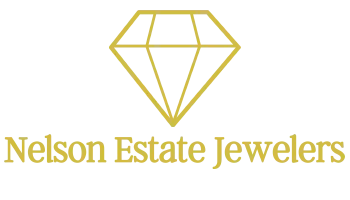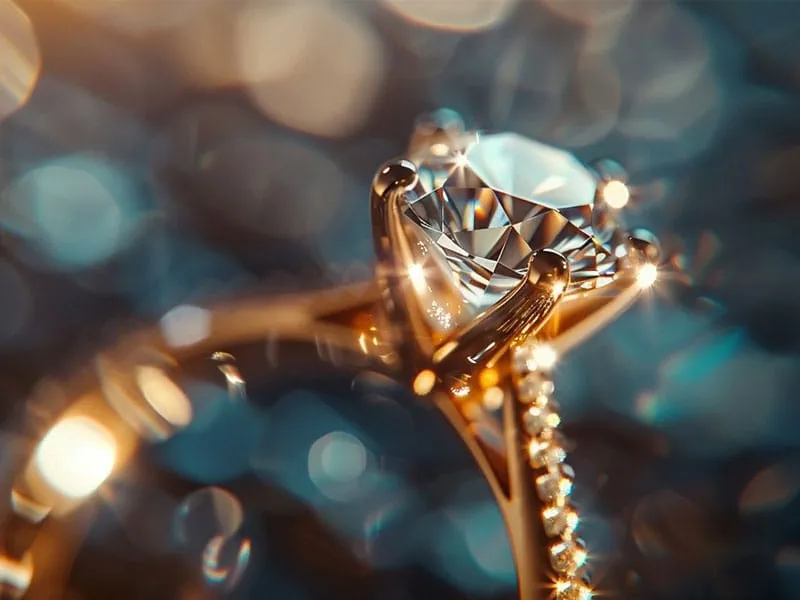
The Ultimate Guide To The 4C’s Carat, Cut, Color, Clarity
Looking for the perfect engagement ring can feel like searching for a needle in a haystack, right?
Here’s a fact: The 4Cs—cut, color, clarity, and carat—are your best friends in this quest.
This guide will break them down into bite-sized pieces, making it easier for you to pick that dream ring. Ready to become an expert?
Key Takeaways
- Diamonds sparkle most when they have a great cut. This means the angles and facets of the diamond catch light perfectly, making it shine bright.
- A diamond’s color can range from totally colorless to yellow or brown shades. Colorless diamonds are rare and valuable, but some colored diamonds can be even more special.
- Clarity tells us how many marks or blemishes a diamond has. The fewer there are, the higher the grade and usually, the more beautiful the diamond.
- Carat is about how much a diamond weighs. More carats mean a bigger size, but it’s not always about being big; how well the other Cs—cut, color, and clarity—come together really makes a difference in its beauty.
- When you know about cut, color, clarity, and carat—the 4Cs—it helps you choose better diamonds that match your style and budget.
What are the 4Cs of Diamonds?
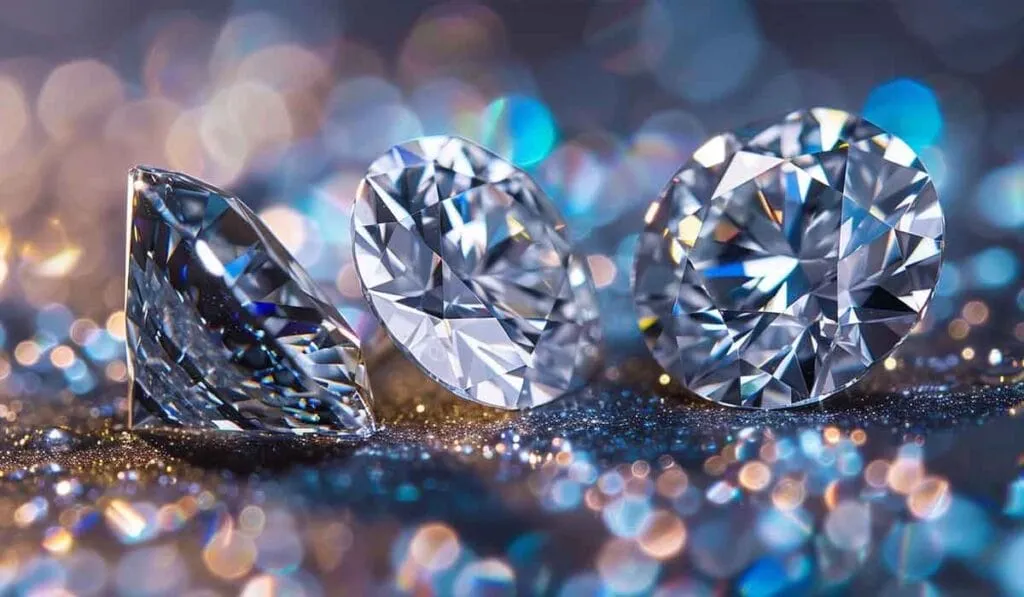
So, you want to know about the 4Cs of diamonds?
Think of them as the secret sauce that makes each diamond shine in its own special way.
Cut
The cut of a diamond isn’t just about its shape—think round brilliant, marquise, or hearts and arrows. It’s the blueprint that decides how much your diamond sparkles. The Gemological Institute of America (GIA) grades cuts from Excellent to Poor, showing how well a gemstone handles light.
Imagine throwing a handful of rainbow confetti into the sunlight; that’s what a top-notch cut offers—a burst of color and brilliance.
A master gemologist takes rough diamonds and chisels them into dazzling pieces of art, ensuring each facet reflects light beautifully.
A diamond’s cut is deep science mixed with pure magic.
Every angle matters. The facets must align perfectly for that eye-catching fire you’re after in engagement rings or necklaces. Think of it like hitting a baseball; it’s not enough to hit it hard—you’ve got to aim right to make it soar out of the park.
And just like in sports, precision leads to breathtaking beauty in diamonds.
Color
Diamond color is a big deal. Think of it as the diamond’s fashion sense—it can really make or break how it looks! Diamonds come in all shades, from totally colorless to yellow tints.
The Gemological Institute of America (GIA) has a fancy scale to measure this, starting from D (totally colorless) and going all the way to Z (light yellow or brown). Colorless diamonds are like unicorns—rare and super valuable.
But don’t count out colored diamonds; some folks go nuts for a pink, blue, or even green diamond. These are called fancy-colored diamonds and they’re in a league of their own.
Now, choosing the right shade can be tricky. A little color might not hurt your wallet as much but getting that icy-white look?
That’s gonna cost you more. And get this—even how a diamond is cut affects its color appearance! So when you’re eyeing that sparkler for your special someone (or hey, yourself)…
Lighter might seem better, but sometimes it’s those unique hues that steal the show. Picking out the perfect balance between lightness and saturation could turn your piece into everyone’s envy—and isn’t that what we’re all after?
Clarity
Let’s crack the code on clarity grades without getting lost in gemologist speak.
Think of clarity as a diamond’s diary, revealing secrets from its time underground. These secrets come in forms like tiny birthmarks or freckles, known to us as inclusions and blemishes.
The fewer there are, the higher the clarity grade climbs—from included (think lots of scribbles) all the way up to internally flawless (clean as a whistle). I once peered through a loupe—a magnifying tool used by pros—and spotted these fascinating marks inside what looked perfect to my naked eye.
Figuring out clarity grading can be akin to finding your way in a foggy city without a map. But here’s something you might find interesting: two diamonds could share the same grade, yet look different under inspection.
Why? Because size, position, color, and quantity of imperfections play big roles too. It’s like how two paintings might have identical frames but tell entirely distinct stories based on their brush strokes and colors used.
So next time you’re marveling at that sparkler, just think—it’s not just about being internally flawless; it’s about how those unique imperfections dance together under the light.
Carat
Carat weight tells you how much a diamond weighs. Think of it like this: a single carat is 200 milligrams, about the same as a paperclip. But don’t let that fool you; more carats doesn’t always mean a bigger stone to the eye.
It’s all about how those tiny grams add up and affect the diamond price. Yes, larger diamonds are rarer and often cost more, but, it’s just one piece of the whole diamond puzzle.
Figuring out carats can be like playing detective with your jewelry. You also have to consider how cut, color, and clarity play into the mix because they all shake hands in determining that final sparkle—and what comes out of your wallet.
Carat weight steps into the dance with them but doesn’t call all the shots by itself. So next time you’re peeking at rings or pendants—whether they’re for gifting or adding to your collection—think about those discreet little weights that might not shout loudest but definitely make their presence felt in both beauty and budget.
Understanding Diamond Cut
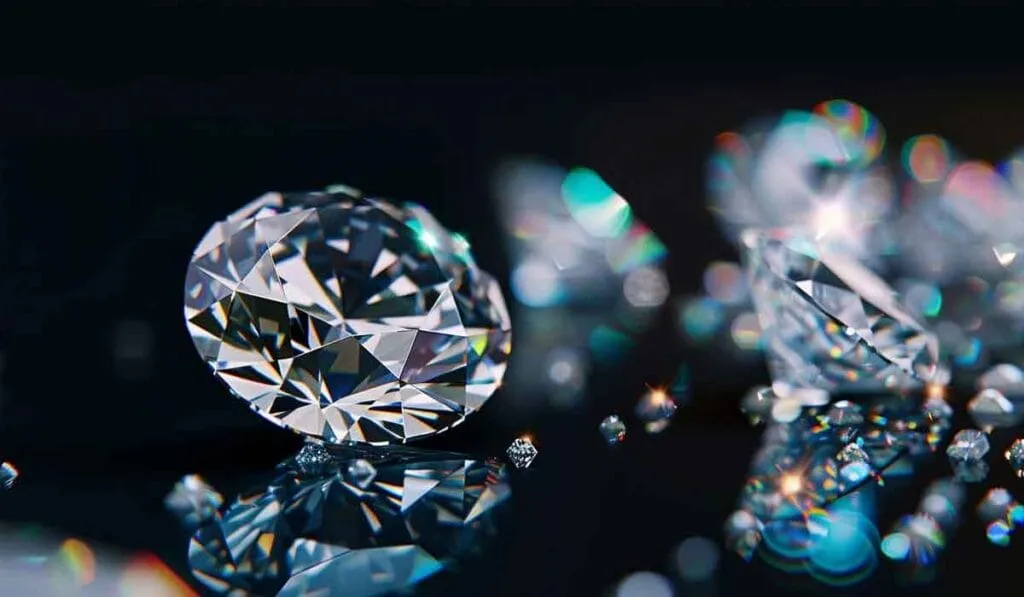
Digging into how a diamond is shaped is like unlocking a treasure chest—every cut decides how much it sparkles! Stay tuned to learn more.
Types of Diamond Cuts
Choosing the right diamond cut can make your gem sparkle like no other. It’s all about finding that perfect balance between brilliance and fire. Here’s a list to guide you through the glittering options:
- Round Brilliant Diamond: This is your go-to for maximum sparkle. Created in the early 20th century, it boasts 58 facets that reflect light beautifully. It’s the most popular choice for engagement rings.
- Princess Cut: Known for its square shape, this cut was popularized in the 1980s. Its sharp angles and contemporary look make it a favorite for modern jewelry pieces.
- Cushion Cut: With rounded corners and larger facets, this vintage-inspired cut dates back to the 19th century. It’s perfect for those who love a soft, romantic glow.
- Marquise Diamonds: Picture a little boat – that’s your marquise! Its elongated shape maximizes carat weight, making it look larger than life on your finger.
- Emerald Cut: Recognize it by its rectangular facets step-cut into the pavilion and its large, open table. This elegant cut emphasizes clarity with its broad, flat planes.
- Oval Diamonds: A twist on round diamonds, oval cuts offer similar brilliance with a unique shape that elongates the finger beautifully.
- Pear Shaped Diamonds: Combining round and marquise shapes, this teardrop beauty is great for those seeking something a bit different but utterly sophisticated.
- Asscher Cut: Named after Joseph Asscher who invented this cut in 1902, it features a symmetrical square shape with deeply cropped corners resembling an octagon.
- Radiant Cut: Imagine combining the best of round and emerald cuts – that’s radiant for you! It’s known for its trimmed corners and vibrant fire.
- Heart-Shaped Diamonds: Nothing screams “I love you” quite like a diamond shaped like a heart. Perfect symmetry is key to making this cut shine bright.
Each cut has its own personality and flair – making your diamond truly yours…
Factors Affecting Brilliance and Fire
Moving from the variety of cuts, let’s get into the sparkle. You know, that eye-catching radiance and fire diamonds are famous for.
Well, several factors play a key role in how much your diamond will twinkle and shine under the lights. Here’s what you need to keep in eye on:
- Quality of Cut: Think of this as the blueprint for sparkle. A well-cut diamond reflects light beautifully, creating that brilliant fire we all love. The Gemological Institute of America (GIA) grades cut quality from Excellent to Poor, so aim for the higher grades.
- Shape of the Diamond: Round brilliants top the charts for brilliance because their shape allows for maximum light return. But don’t count out other shapes; some like the oval or pear can also pack quite a punch in the sparkle department.
- Symmetry: Imagine symmetry as a dance where each facet of a diamond moves in harmony. Even a slight misstep can dim its performance under the spotlight.
- Proportion: This is about balance—how the diamond’s parts size up against each other. Get this right, and you’ll see an internal reflection that’s nothing short external magic.
- Polish: You want a smooth mover here; rough spots can dull your diamond’s shine faster than a cloudy day.
- Type of Setting: Let’s talk stage settings—the metal framework holding your gemstone impacts its brilliance too! Lighter metals like white gold or platinum can enhance reflections inside your diamond, making it dazzle even more.
- Lighting Conditions: Have you ever noticed diamonds seem to sparkle more in certain lights? That’s because direct sunlight or LED lighting brings out their best performance while softer lights might not make them shine as bright.
- Presence of Fluorescence: This is like your diamond’s secret power under ultraviolet light! Some fluoresce, giving off a soft glow that can actually make some lower-color diamonds look whiter than they are—a neat trick for sure.
- Color Grade: Lighter colored diamonds tend to show more brilliance and fire compared to deeply colored ones due to their ability to reflect light cleaner and brighter.
Every choice, from selecting a blue diamond with fluorescence to opting for an Asscher cut set in rose gold, influences how brilliantly your diamond will perform on life’s stage.
And don’t forget, while bigger carats may catch eyes from afar, it’s these factors that keep one enchanted up close.
Exploring Diamond Color
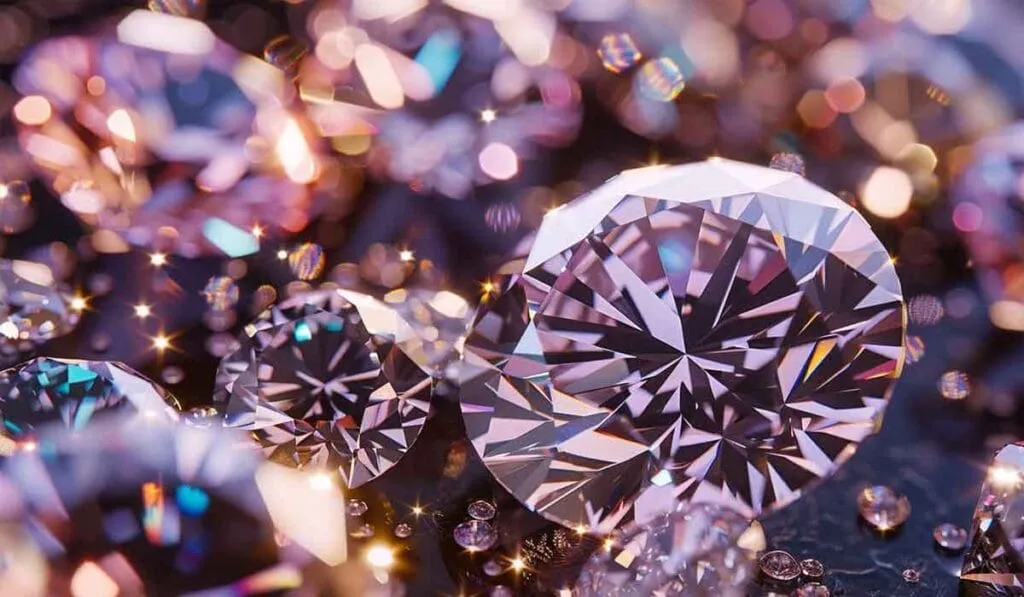
Exploring the colors of diamonds is like opening a box of crayons—each shade tells a different story.
The Diamond Color Scale
Let’s get straight to the heart of diamonds: their color. Imagine a world painted in shades of colorless to yellow. That’s the universe of the diamond color scale. It’s a spectrum that judges how colorless a diamond is, and believe it or not, this scale can make or break the value and appeal of that sparkly rock you’re eyeing.
Here’s a friendly guide to making sense of the diamond color scale. We’ve laid it all out in an easy-to-digest table.
| Grade | Color Visibility |
|---|---|
| D | Absolutely colorless. The unicorn of diamonds, extremely rare. |
| E-F | Colorless. Only a gemologist can spot tiny bits of color. |
| G-H | Near colorless. Super hard to see color unless compared side-by-side with better grades. |
| I-J | Slightly tinted, usually yellow. Still looks pretty clear to the untrained eye. |
| K-M | Noticeably color-tinted, usually yellow. Think of it as a diamond with a hint of sunshine. |
| N-Z | Very noticeable color. At this point, it’s more about the warmth of the tint than the absence of color. |
So, what’s the big deal with color, or the lack thereof? Well, diamonds are all about the sparkle, and the less color, the more sparkle. That’s because colorless diamonds allow the most light to travel through them, creating that dazzling brilliance we all love.
But don’t sweat it if you’re drawn to a stone with a warmer hue. Beauty is in the eye of the beholder, and sometimes, a little color adds character. It’s like choosing between a crisp, clear winter morning and a warm, golden sunset—both are stunning in their own right.
Diamonds are like snowflakes, no two are exactly alike. And while the color scale can guide you, your personal taste should always have the final say.
So, go ahead, pick the diamond that catches your eye and makes your heart skip a beat. After all, it’s not just about the grades, but how it makes you feel.
Impact of Color on Value
So, after getting cozy with the diamond color scale, it’s time to shine a light on how that color influences value. Think of diamonds like ice cream – sure, vanilla is classic, but sometimes a scoop of vibrant strawberry or rich chocolate can really wow your taste buds.
When you talk about sparkly rocks, those fancy vivid and fancy intense hues are your strawberry and chocolate. They’re not just eye-catching; they come with a heftier price tag too.
Color in diamonds plays a massive game of “Catch me if you can” with its value. The clearer a diamond, starting from that icy D all the way down to Z’s warm tones—it’s usually more prized and pricier.
But then comes the plot twist: enter blue diamonds, pink diamonds… these rebels flip the script! Their rarity skyrockets their worth—making them some serious contenders for anyone looking to invest or make that engagement ring extra special.
So, while clear gems scream luxury, colored stones whisper tales of uniqueness impossible to ignore.
In diamonds as in life—attractive differences often come with unique values.
Clarifying Diamond Clarity
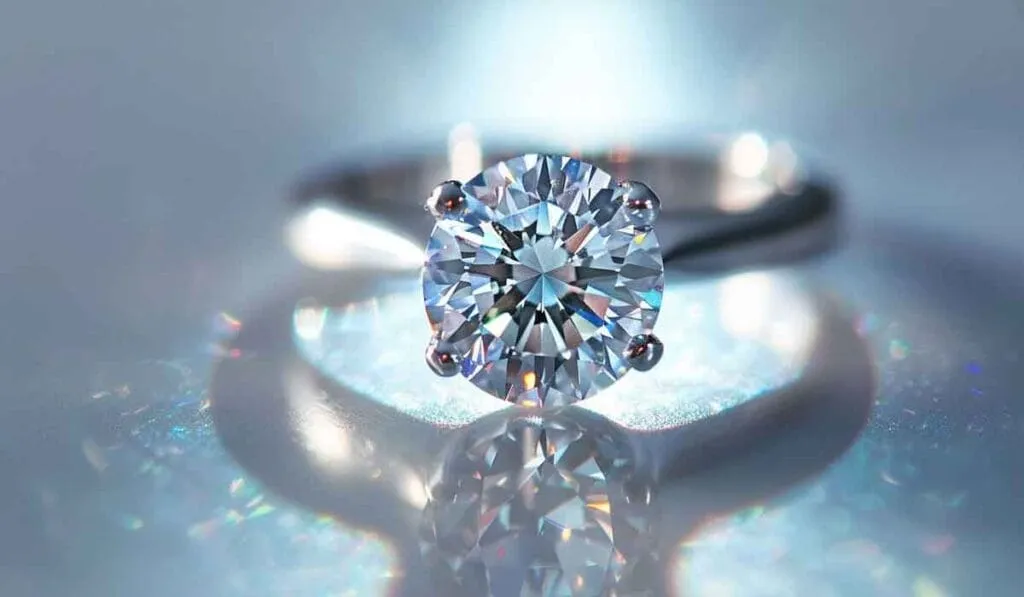
Digging into diamond clarity is like playing detective with a magnifying glass. Every little mark or blemish inside your gem tells its own story, making each one truly special. Ready to be a clarity sleuth? Dive in and discover what makes your diamond sparkle!
Clarity Grades
Ah, diamonds—so sparkly, so mesmerizing, and yes, so full of terms that can make your head spin faster than a disco ball. Today, you and I are about to become best friends with one of those terms: The Clarity Grades. It’s like knowing the secret handshake in an exclusive club—pretty cool, huh?
So, diamonds, right? They’re not just random pieces of bling. They’ve got this grading system that’s all about how clear they are, or in fancy speak, their “clarity.” It’s a big deal because it talks about the little imperfections inside or on the diamond.
Think of it like this: Diamonds are like snowflakes, no two are exactly alike. These imperfections are called “inclusions” for the stuff inside and “blemishes” for the stuff on the surface.
Now, let’s break it down with a handy-dandy table.
| Clarity Grade | Description |
|---|---|
| FL (Flawless) | No inclusions or blemishes visible under 10x magnification. Like the unicorn of diamonds. |
| IF (Internally Flawless) | No inclusions and only insignificant blemishes under 10x magnification. Almost a unicorn. |
| VVS1, VVS2 (Very, Very Slightly Included) | Minute inclusions that are hard for even a pro to see under 10x magnification. Think of it as a ninja—there, but super hard to spot. |
| VS1, VS2 (Very Slightly Included) | Minor inclusions seen with effort under 10x magnification. Like finding Waldo—challenging, but doable. |
| SI1, SI2 (Slightly Included) | Inclusions are noticeable under 10x magnification. No ninja moves needed here, more like spotting a cat in a sunbeam. |
| I1, I2, I3 (Included) | Inclusions are obvious under 10x magnification and may affect transparency and brilliance. Like a cat that’s knocked over a vase—pretty hard to ignore. |
Isn’t that table just the ticket for making sense of it all? Now, when you’re out there shopping for diamonds, you’ll have a bit of know-how to keep in your back pocket.
Keep in mind, clarity is just one piece of the puzzle, but it’s a shiny, fascinating piece indeed.
So, there you have it. You’re now in the know about diamond clarity grades, armed and ready to tackle the sparkle with confidence.
And hey, next time someone starts talking about diamond inclusions, you’ll be all, “Oh, you mean the internal characteristics as defined by the GIA’s clarity grading system?” Watch them be impressed.
How Inclusions Affect Appearance
Inclusions are like tiny birthmarks inside a diamond, making each stone tell its own story. Think of them as the fingerprints of gemstones; no two diamonds will share the exact same pattern of inclusions.
But here’s the kicker: These small imperfections can affect how your diamond sparkles and shines. If a diamond has many visible inclusions, it might look cloudy or less brilliant. In my first-hand experience peering through a jeweler’s loupe, I’ve seen how these little blemishes can impact a diamond’s clarity and overall beauty.
Seeing is believing–inclusions shape our perception of every gemstone.
Graduate gemologists use tools like magnifying glasses to grade these flaws from ‘Included’ (where marks are obvious) to ‘Flawless’ (no visible inclusions). This grading affects not just appearance but also price.
So, finding that sweet spot where inclusions don’t overly mar the appearance but keep the diamond within budget becomes key during selection.
Next up, let’s weigh up how much size really matters with carat weight…
Determining Diamond Carat
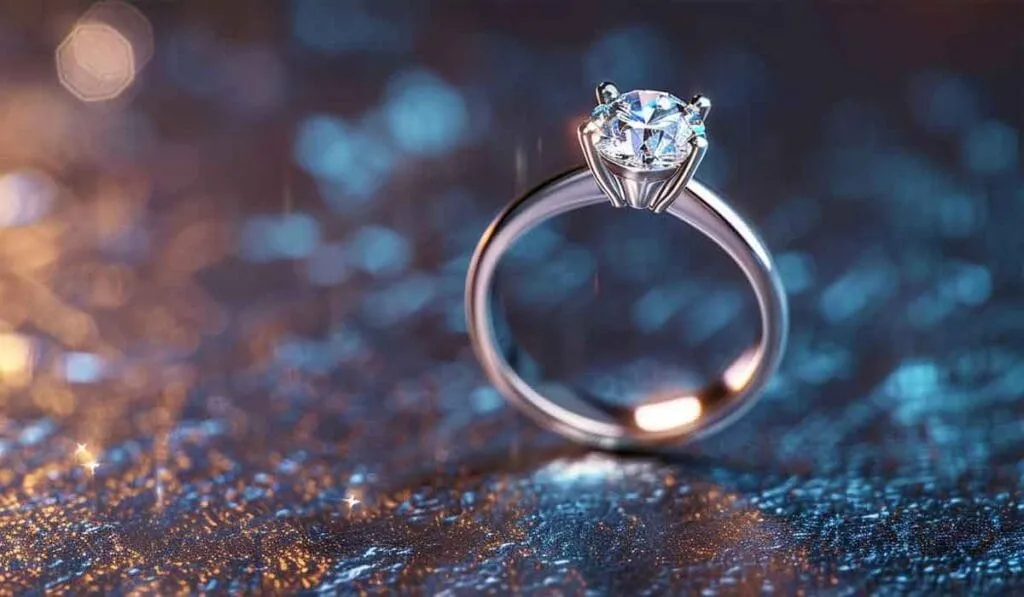
Determining the weight of a diamond — that’s what carat is all about. But hey, it’s not just a number! It plays a big role in how big that sparkler looks on your finger.
Carats can be tricky; more carats might mean a bigger jewel, but don’t forget, it needs to play nice with cut, clarity, and color to really shine.
So when you’re eyeing that perfect piece for your ring or necklace, keep in mind: size matters, but it’s part of a bigger picture. Explore the sparkle to find your gem’s true magic!
Carat vs. Size Perception
A diamond’s carat tells you about its weight, not how big it looks. Think of carat as the diamond’s physical heft. Two diamonds can weigh the same but look different in size. It’s a magic trick of sorts, where cut plays the lead role.
A well-cut diamond spreads out its sparkle and seems larger to the eye than a deeper, poorly cut stone of the same weight.
Carat packs a punch in pricing too. Heavier diamonds cost more because they are rare finds under Earth’s surface. But here’s an insider tip: sometimes slightly lighter diamonds have nearly the same look for less cash!
This little nugget is why understanding carat along with cut, color, and clarity can save your wallet from crying when picking out that perfect gemstone for engagement rings or bracelets.
Carat and Its Relation to Other Cs
Carat weight might seem like it’s all about size, but it has a secret dance with the other Cs that changes the tune. Think of carat as the lead in this dance—it grabs your attention first because everyone loves a big diamond.
But if cut, color, and clarity don’t step up to match, our star can lose its sparkle. You see, a heavier diamond isn’t worth much if it looks like a tiny disco ball throwing light in all the wrong directions.
It’s kind of like baking a giant cake with mediocre ingredients; size alone doesn’t make it delicious.
Ever noticed how some diamonds just sing? I once held two stones side by side: both were 1-carat each—yet one outshone the other as if it had an inner fire. That’s because even though they weighed the same, their cut quality and clarity grades were worlds apart.
A perfectly cut diamond scatters light so well, you forget to ask how heavy it is. This experience taught me that while we often chase after carats hoping for more bling, what really turns heads is how these elements play together—creating something truly unforgettable.
A great performance depends not on the role but on how well the actor plays.
The Importance of the 4Cs in Diamond Selection
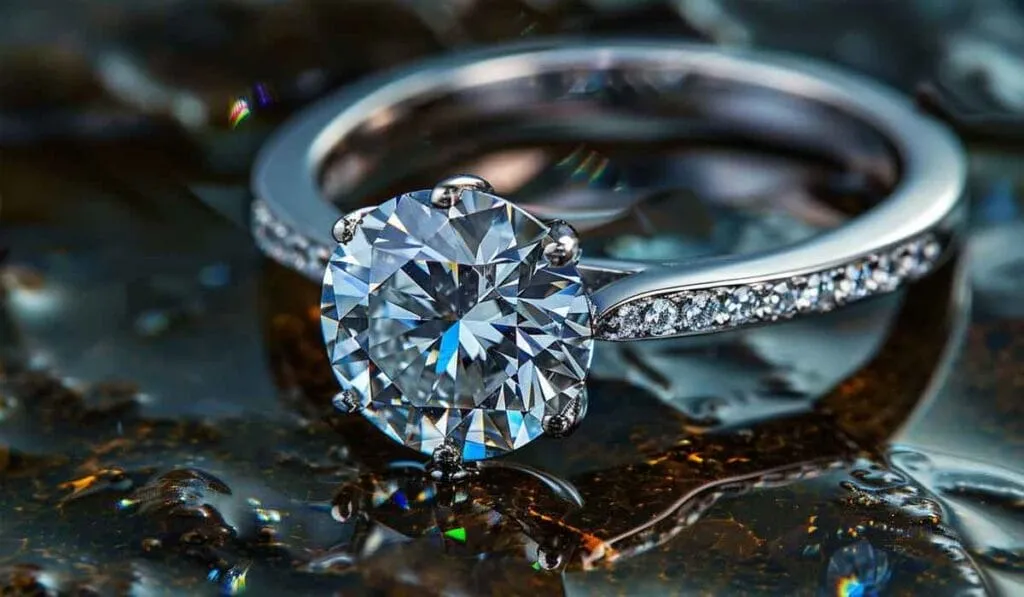
Choosing the right diamond boils down to knowing your 4Cs—cut, color, clarity, and carat. Think of them as your compass in the sparkling world of diamonds. They guide you to find a gem that shines just right for you.
It’s like choosing a team member; each trait plays a critical role in making sure your choice stands out. So, don’t miss out on learning more about how these four characteristics work together to bring out the best in a diamond!
How Each C Affects Diamond Quality and Value
Picking the perfect diamond is like choosing a best friend—looks matter, but it’s what’s inside that counts too. Each of the 4Cs plays a crucial role in determining the overall quality and value of a diamond.
- Cut: The cut is about how well a diamond has been shaped and faceted. A well-cut diamond, like the popular brilliant round or fancy Asscher cuts, captures light beautifully, making it sparkle like crazy.
Think of it as the diamond’s personality; if done right, it shines bright. But if the cut is poor, even with good color and clarity, it’ll look dull. GIA grading really pays attention to this aspect because it strongly influences a diamond’s brilliance—that special sparkle that catches your eye from across the room. - Color: Diamonds come in shades ranging from colorless to light yellow or brown and even fancy colors like pink or blue called fancy colored diamonds.
The GIA grading system categorizes them from D (totally colorless) through Z (light color). Here’s a fun fact: Colorless diamonds are rare birds and fetch higher prices, but some people fall head over heels for diamonds with warm colors or slight tints because they ooze character. - Clarity: Imagine finding an utterly perfect natural diamond. That’s rare! Most diamonds have tiny imperfections called inclusions (internal) and blemishes (external).
Clarity grades range from Flawless (no inclusions visible under 10x magnification) down to Included categories (inclusions visible to the naked eye), such as SI3 and VS2 clarity levels often discussed by jewelers and gem labs. Fewer inclusions mean a pricier gem because it’s close to being perfect. - Carat: This one’s about weight, not size—but let’s not get caught up in semantics. More carats generally mean more money out of your pocket, especially if those carats are tied up in high-scoring stones for cut, color, and clarity too.
Yet here is where things get interesting: two diamonds can weigh the same but look different sizes due to their cut quality! Plus, how big that rock looks on your finger also depends on its proportions and style setting.
Each C pulls its weight in determining a diamond’s charm and check-out price at places like engagement-ring stores.
So there you have it—all set to find that dazzling piece that just speaks to you? Keep these Cs in mind; they’re your best pals in this shiny adventure.
Conclusion
So, you’ve journeyed through the sparkle and shine of diamonds, learned about cut, color, clarity, and carat. Think of these 4Cs as your compass in diamonds. They guide you to find that perfect gem.
It’s like being a detective with a magnifying glass—every detail counts. And hey, whether it’s for a gift-card surprise or investing in lab-grown diamonds, knowing these details can save you some cash and add extra glitter to your smile.
Keep this in mind: each C plays its part in the diamond’s story. Cut brings out the sparkle; color adds character; clarity tells a tale of uniqueness; carat weighs in with heft and size.
Mix them right, and boom—you’ve got yourself not just a rock but a masterpiece.
So next time you’re eyeing those wedding rings or pondering over diamond prices, let the knowledge of the 4Cs be your hidden ace card! Diamonds might last forever, but making smart choices starts now—with you armed to the teeth with all things shiny and brilliant.
FAQs
1. What’s the big deal about the 4Cs in diamond grading?
Think of the 4Cs—cut, color, clarity, and carat—as your secret map to treasure hunting in the world of diamonds. They’re like the compass, telescope, sword, and parrot on a pirate’s shoulder! The cut makes sure your diamond sparkles like a star in a dark sky. Color? It’s all about how clear or yellow that gem looks. Clarity is checking if there are any tiny blemishes hiding inside or on its surface. And carat? That’s just how much this little rock weighs on the scales.
2. How does “cut” make my diamond sparkle more than my neighbor’s?
Imagine you’re sculpting ice for a fancy party—you want it to catch every light in the room and dazzle everyone who walks by. A brilliant cut does exactly that for diamonds; it’s like giving them superpowers to capture light and throw it back at you with all its might!
3. Is choosing a color for my diamond really like picking out paint swatches?
Sort of! With diamonds though, we’re often looking for what’s not there—a lack of color means higher grades here! Think ghost-white or crystal-clear waters from those vacation brochures; that’s what top-tier diamond colors are compared against.
4. Why should I squint at tiny marks when looking at clarity?
These little imperfections are like birthmarks—they tell a story about where your diamond came from but don’t worry too much unless they mess with its sparkle under bright lights or make it look cloudy.
5. Does bigger always mean better when talking about carats?
Not always! Imagine two cookies—one huge but bland and one smaller packed with flavors—that second one is going to win every time right? It’s similar with diamonds; size (carats) matters but doesn’t trump brilliance (cut), beauty (color), or secrets (clarity). Sometimes less is indeed more if everything else shines brighter!
Remember, whether you’re eyeing wedding rings or thinking about investments—knowing these basics can help steer you clear of rough seas into calm harbor waters where your perfect gem awaits!
